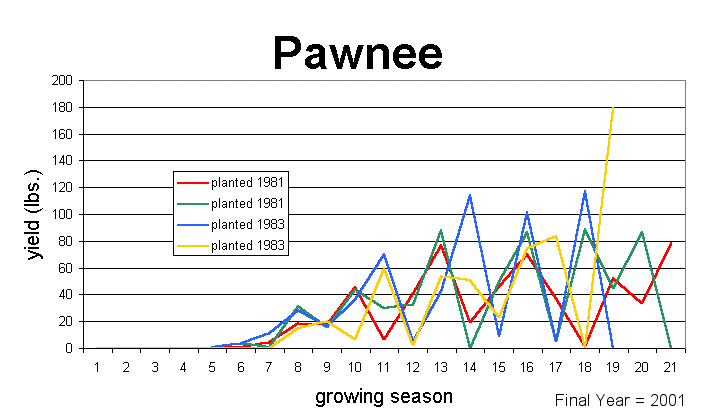Pawnee
Average nut quality of mature test trees from year 1 to 20 from an older trial.
| # Nuts / lb. | % Kernel | Kernel quality breakdown | Specific gravity | ||
| % Fancy | % Standard | % Amber | |||
| 56 | 54% | 20% | 33% | 1% | 0.80 |
Average nut quality of young test trees from 2005-2012.
| Cultivar | Yield | #Nuts/lb. | %Kernal | Cluster Size | Harvest Date | ||
| lbs./tree/year | (50% shuck split) | ||||||
| Pawnee | 5.5 | 45 | 56% | 3.7 | Sept. 10 | ||
| Desirable | 6.1 | 40 | 50% | 2.8 | Oct. 14 | ||
Average pest resistance of test cultivars 2006-2010.
| Cultivar | Leaf ScabZ | Nut ScabY | Black Aphid DamageX | Sooty Mold BuildupW |
| Avg. (worst)V | Avg. (worst) | Avg. (worst) | Avg. (worst) | |
| Pawnee | 1.0 (1.0) | 1.5 (2.0) | 1.6 (2.0) | 1.0 (1.0) |
| Desirable | 2.1 (4.0) | 3.4 (4.4) | 1.4 (2.7) | 1.0 (1.0) |
- Z 1=No scab, 2= Few stray spots, 3=Several spots with expanding lesions, 4=Stem scab or defoliation.
- Y 1=No scab, 2=Few stray spots, 3=Obvious scab but no quality loss (0-10%), 4=10-50% shuck coverage, 5=50-100% covered, nut drop.
- X 1=No damage, 2=Light spotting, less than 25% leaves affected, 3=Moderate spotting, 25-75% leaves, 4=Heavy spotting, >75% leaves affected, some leaves completely yellow.
- W 1=None, 2=Light, some black on few leaves, 3=moderate, black on most leaves, 4=Heavy, black flakes on leaves and stems.
- V Average score over all years and average of worst year for each trait.
History
'Pawnee' is from a cross of 'Mohawk' x 'Starking Hardy Giant', made in Brownwood, Texas, in 1963. Since then, this cultivar has become very popular throughout the Western and Northern growing regions (Thompson and Grauke, 2000), and is gaining in popularity in the Southeast as well.
Comments
The most outstanding feature of 'Pawnee' is its large nut size combined with very early nut maturity. The average harvest date for 'Pawnee' at Tifton has been in the 3rd week of September. Nuts stagger their opening, with some shucks being open very early in September.
Yields from 'Pawnee' have been good. Our yield data indicate that 'Pawnee' is not an extremely precocious cultivar. Average yield for years 1-10 were similar to 'Sumner' and about half that of 'Cape Fear'. As a mature tree, years 11-20, 'Pawnee' was a top producer of usable kernels. In addition, significant depredation from crows occurred in many years leading to lower recorded yields than what the trees actually produced. 'Pawnee' does tend to produce alternately, but kernel quality did not decline dramatically in the ON year. Mature 'Pawnee' trees would probably benefit from mechanically shaking off excess crop, especially if trees are crowded.
'Pawnee' produces a high-quality nut of medium to large size (55.9 nuts/lb.). Percent kernel has been good and stable, with only one year falling below 50%. 'Pawnee' produces a light colored kernel with excellent quality. However, color darkens quickly in storage, and the kernel can become stained if the nuts are rained on after shaking the trees, necessitating a prompt harvest and use to retain maximum quality. Some growers have complained about a speckling on the kernels (see pictures below), we have observed this as well, but it has not been a large problem in our test. This trait may, however, prohibit 'Pawnee's' usefulness in the gift-pack trade.
'Pawnee' is reported to have good resistance to aphids (Thompson and Grauke, 2000). 'Pawnee' is definitely susceptible to scab, and will need a full-season fungicide spray program. In 2005 and 2006 'Pawnee' has showed more damage from nut scab than the 'Desirable' trees planted next to them. In fact, in 2005 the 'Pawnee' crop was severely damaged due to scab despite a full season fungicide program. However, in recent years, with less scab pressure, 'Desirable' had much more damage than 'Pawnee'. We do not recommend 'Pawnee' be planted in south Georgia where scab control is likely to be a concern unless the grower has the ability to maintain very good fungicide coverage. I still like 'Pawnee' in mid-Georgia where it is a proven performer. Growers may wish to consider 'Byrd' and 'Mandan' as replacements for 'Pawnee', but they each have their own issues and are unproven over the long-term.
Like 'Desirable', 'Pawnee' is protandrous, meaning the pollen is shed before the stigma is receptive, and is a good early season pollinator. 'Cunard', 'Elliott', 'Kanza', 'Lakota', 'McMillan', 'Morrill', 'Schley', 'Stuart', 'Sumner', or 'Sioux' will pollinate 'Pawnee'.
The early harvest and good productivity and quality of 'Pawnee' make it a promising cultivar if it is carefully managed. However, the early harvest date also makes 'Pawnee' more difficult to incorporate into an existing orchard, especially if only a few trees are planted. Depredation by squirrels and especially crows can be severe if trees are isolated in an orchard among later maturing cultivars. In order to lessen depredation and facilitate prompt harvesting, 'Pawnee' should be planted together in relatively large blocks. We have also noted that 'Pawnee' seems to open shucks over a longer period of time than many cultivars, requiring the trees to be shaken more than once, especially to limit the depredation by animals.
'Pawnee' is a good northern cultivar and should do well in northern Georgia and other mid-northern growing regions.
Production record of test trees beginning in year planted
'Pawnee' production from the Ponder Variety Grove test. Each colored line represents the yearly production in pounds of nuts from an individual tree beginning the year planted. *Note the up and down of the alternate bearing cycle.
Alternate Bearing Intensity = 0.61



